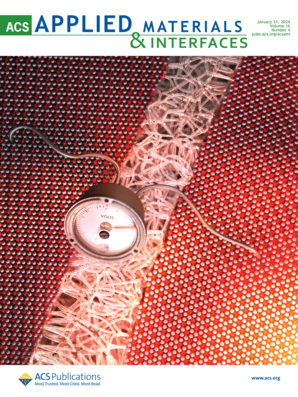基于机器学习的SERS传感器:多重检测食源性致病菌中的脂多糖。
IF 8.3
2区 材料科学
Q1 MATERIALS SCIENCE, MULTIDISCIPLINARY
引用次数: 0
摘要
食源性致病菌对公共卫生构成全球性威胁,造成危险和昂贵的疫情。虽然正在开发针对耐抗生素细菌和食源性致病菌的治疗方法,但尽量减少其传播的方法也至关重要。据世界卫生组织估计,每年报告的食源性疾病病例约为6亿例,死亡人数超过42万。脂多糖(lipopolaccharides, LPS)是存在于革兰氏阴性菌外膜上的糖脂类物质,是病原菌的生物标志物。由于需要一个传感平台来快速和经济有效地检测和鉴定微生物病原体,本工作的重点是基于表面增强拉曼散射(SERS)的细菌传感器,用于检测来自各种致病菌的LPS。具体来说,将对LPS具有广泛亲和力的线性聚合物亲和剂固定在纳米球等离子体基底上的金属薄膜上,并结合机器学习分析来表征和区分来自鼠伤寒沙门氏菌、大肠杆菌O111:B4和大肠杆菌O26:B6的LPS的拉曼“指纹”。我们的研究结果证明了基于线性聚合物的SERS传感平台与主成分分析和支持向量机的机器学习分析相结合的可行性,即使在苹果汁等复杂的食品基质中,也能对不同细菌种类的LPS进行敏感检测和区分,突出了其在食品安全监测中的实际应用潜力。本文章由计算机程序翻译,如有差异,请以英文原文为准。
A Machine Learning-Enabled SERS Sensor: Multiplex Detection of Lipopolysaccharides from Foodborne Pathogenic Bacteria.
Foodborne pathogenic bacteria pose a global threat to public health, causing dangerous and expensive outbreaks. While therapeutics are being developed to target antibiotic-resistant and foodborne pathogenic bacteria, approaches to minimize their spread are also crucial. As estimated by the World Health Organization, each year around 600 million cases of foodborne illnesses are reported, with over 420,000 deaths annually. Lipopolysaccharides (LPS) are glycolipids found on the outer membrane of Gram-negative bacteria, serving as biomarkers for pathogenic strains. With a clear need for a sensing platform to quickly and cost-effectively detect and identify microbial pathogens, this work focuses on surface-enhanced Raman scattering (SERS)-based bacterial sensors for the detection of LPS from various pathogenic bacteria. Specifically, linear polymer affinity agents with a broad affinity for LPS immobilized on metal film over nanosphere plasmonic substrates and the integration of machine learning analysis are used to characterize and discriminate between the Raman "fingerprints" of LPS from Salmonella typhimurium, Escherichia coli O111:B4, and Escherichia coli O26:B6. Our findings demonstrate the feasibility of a linear polymer-based SERS sensing platform coupled to machine learning analysis with principal component analysis and support vector machines for the sensitive detection and differentiation of LPS from different bacterial species, even in a complex food matrix like apple juice, highlighting its potential for real-world applications in food safety monitoring.
求助全文
通过发布文献求助,成功后即可免费获取论文全文。
去求助
来源期刊

ACS Applied Materials & Interfaces
工程技术-材料科学:综合
CiteScore
16.00
自引率
6.30%
发文量
4978
审稿时长
1.8 months
期刊介绍:
ACS Applied Materials & Interfaces is a leading interdisciplinary journal that brings together chemists, engineers, physicists, and biologists to explore the development and utilization of newly-discovered materials and interfacial processes for specific applications. Our journal has experienced remarkable growth since its establishment in 2009, both in terms of the number of articles published and the impact of the research showcased. We are proud to foster a truly global community, with the majority of published articles originating from outside the United States, reflecting the rapid growth of applied research worldwide.
 求助内容:
求助内容: 应助结果提醒方式:
应助结果提醒方式:


